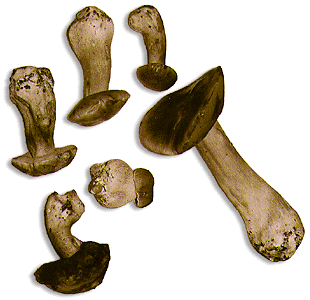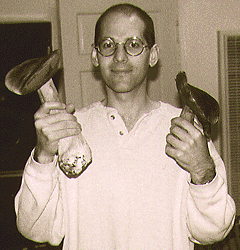 Boletus edulis
Boletus edulis Boletus edulis
Boletus edulisWhat can I say about this mushroom that hasn't already been said? To my palate, no other mushroom surpasses the gustatory heights of B. edulis, otherwise known as the porcini, cèpe, steinpilz, and king bolete. After the first Autumn rains, this mushroom haunts my dreams. Perhaps only the morel can capture a fungophile's imagination as piquantly as this.
To be honest, the cèpe has several close relatives that share some of the same identifying features, and taste just as good, including B. aereus and B. barowsii. I don't have first-hand experience with these other species, but the books rate them highly.
The flesh of B. edulis does not discolor when handled, nor does it bruise blue like many other boletes. The pores of young specimens are creamy white, turning tan to brown with an olive green tint in age. The flesh is white with occasional brown areas at the base. Occasionally they grow huge (see photo below) but the large ones usually become squishy and bug-eaten. In fact, maggots and humans both love this mushroom, and they compete voraciously for every specimen. Vegetarian mushroom hunters soon learn to loosen their standards and tolerate a bit of extra protein when it comes to porcini.
 The flavor is nutty, meaty, buttery, savory, almost sweet,
and slightly reminiscent of the soil from which it grew. You can taste just
a hint of the smell of the forest, but within a matrix of rich, warm complex
flavors. Older specimens can become soft and slightly slimey when cooked,
and for this reason can actually improve when dried. Drying the porcini
seems to accentuate its sweet and meaty overtones, reducing "l'eau
du terre" (smell of the earth) that distinguishes fresh boletes. When
reconstituted, the liquid retrieved from soaking the cèpes makes
a perfect soup base, needing almost no additions.
The flavor is nutty, meaty, buttery, savory, almost sweet,
and slightly reminiscent of the soil from which it grew. You can taste just
a hint of the smell of the forest, but within a matrix of rich, warm complex
flavors. Older specimens can become soft and slightly slimey when cooked,
and for this reason can actually improve when dried. Drying the porcini
seems to accentuate its sweet and meaty overtones, reducing "l'eau
du terre" (smell of the earth) that distinguishes fresh boletes. When
reconstituted, the liquid retrieved from soaking the cèpes makes
a perfect soup base, needing almost no additions.
This photo shows me with the first two Boletus edulis I ever found. The one in my left hand was a bit on the old side, but delicious nevertheless!
Here's a few recipes that use boletes: